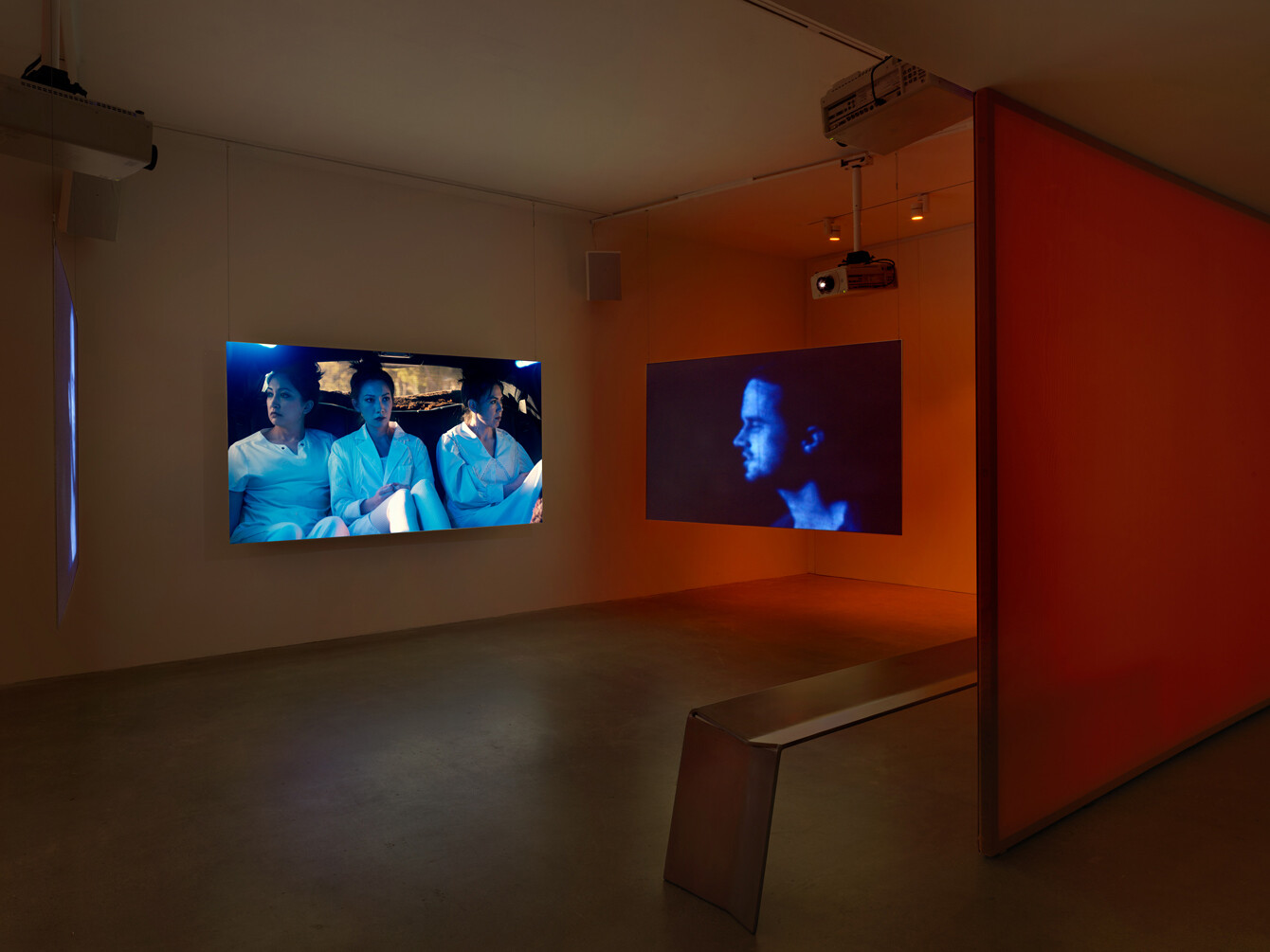

Exhibition view: “List Projects 26: Alison Nguyen,” MIT List Visual Arts Center, 2023. Photo: Dario Lasagni.
This dialogue is published in connection with Alison Nguyen’s solo exhibition at MIT List Visual Arts, “List Projects 26: Alison Nguyen” (February 23–June 25, 2023) and her artist talk at e-flux Screening Room on May 23, 2023. The conversation centers on Nguyen’s current body of work, “history as hypnosis.”
***
Min Sun Jeon: Over the years you have worked across many forms—video installation, film, performance, text, and prints, not to mention a sculpture involving the back section of a severed car! While you are expanding your choice of mediums, your reflection on the role of technology and how it affects political conditions, social relations, and individual psychology has remained consistent in your work over time. Can you talk about how you arrived at this body of work? What do you think has remained and what has changed?
Alison Nguyen: The latest film, history as hypnosis, is in some ways an extension of ideas in my previous work centering on Andra8, a computer-generated woman living and working in an orange virtual void. However, formally it’s completely different. The world of Andra8 was created in a game engine, and though I performed most of the movements as the character in a physical space in a motion-capture suit, the majority of the process took place on the computer. history as hypnosis is definitely a departure: it’s a live-action film wherein I use the veneer of “real” environments (primarily Southern California) to create the world of a speculative fiction.
I suppose this is a characteristic of my practice; the cohesion of my work is more in the concepts and research than the material realization. When I begin a project there is usually a personal impulse that connects to broader ideas I’m fixated on. I seek formal ways to explore what’s at stake and often there’s quite a lot of research, material experimentation, new skills to be learned, fuck-ups. I pay attention to the latter; these tend to be important parts of the process. Often a moving-image piece is at the center of the constellation of the body of work. Sculpture, prints, and text are extend from the video work, yet can also exist independently.
In making the Andra8, I found that there was something about my own performance—which was new to my work at the time—that allowed me to embody ideas as opposed to comment on them. It allowed me to say things in a nondidactic way that I couldn’t express in other mediums. This opened up a whole other mode of working for me; the slippages within performance and also within the technological processes were so compelling. Yet towards the end of it I got sick of making work using mostly digital tools. It was too much time on the computer. So on a personal level, I wanted to experiment with making a film with other performers in a tangible space, picking at cinematic tropes. Never in recent years did I think I would pull out a camera and shoot a film! This more straightforward mode of filmmaking had always seemed so fucking square. And yet around this time last year it felt like a natural progression. I had to challenge myself: How do I make a live-action film on my own terms? How do I create the production conditions for a work to host these slippages?
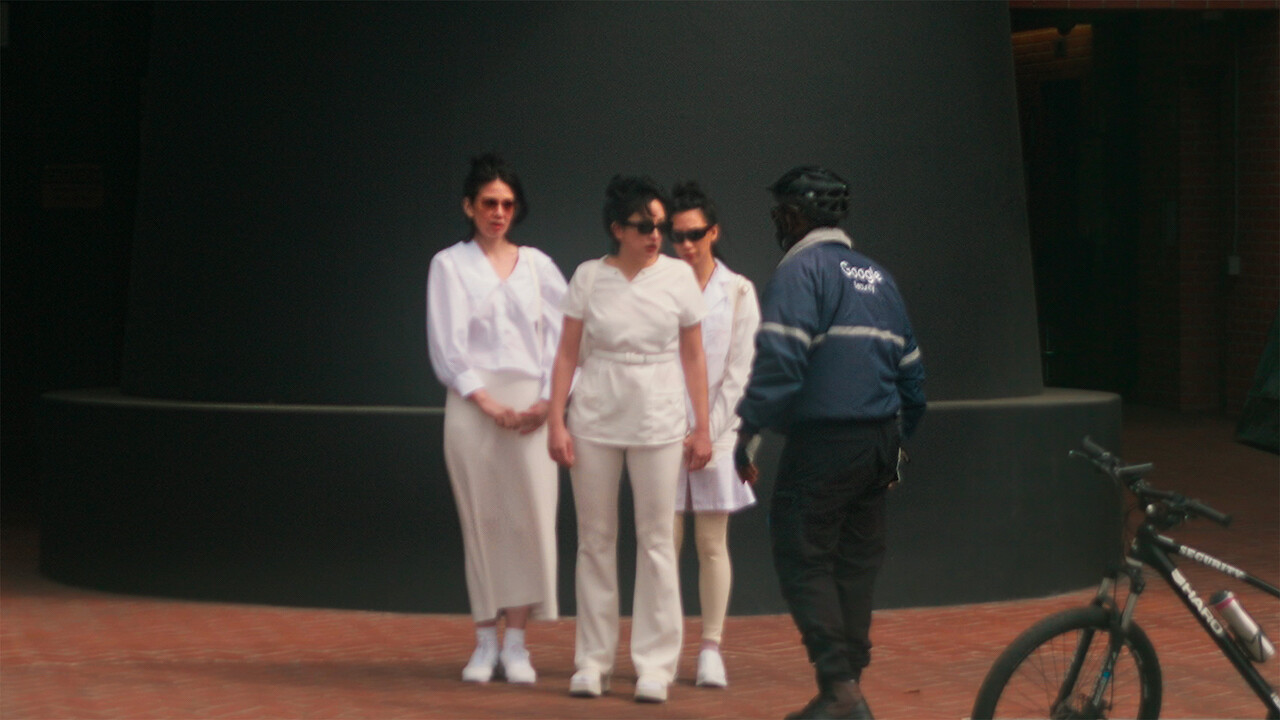

Alison Nguyen, history as hypnosis (Cinema Version), 2023. Single-channel video, color, sound, 30 mins.
MJ: Interesting. You performed in history in hypnosis as one of three main characters. The fact that you partake in your own work as a performer gestures toward your will to bring out the personal. And then you made the character you played seemingly detached, which transcends individuality to explore broader concepts. It seems to me that you synthesize the particulars of the personal with larger social issues and ideas. How did you navigate or negotiate this interplay between individual recollection and collective or cultural memory? How did you navigate the history and ramifications of America’s war in Vietnam and the themes of alienation and assimilation that permeate this film?
AN: One of the seeds of history as hypnosis is a personal one: a semi-autobiographical poem, entitled “Cu” (the Vietnamese word for “penis”), by my brother Matthew Nguyen. It recounts our bizarre childhood outings in my uncle’s old used limousine. My uncle, who immigrated from Saigon to the US during the war, didn’t drive limousines for a living; he purchased the vehicle as his everyday car. He took a deranged joy in driving a wild troupe of his young nieces and nephews around Washington DC. My uncle was obsessed with taking us to the Smithsonian Air and Space Museum, which is more or less a fancy storage container for vehicles from US wars.
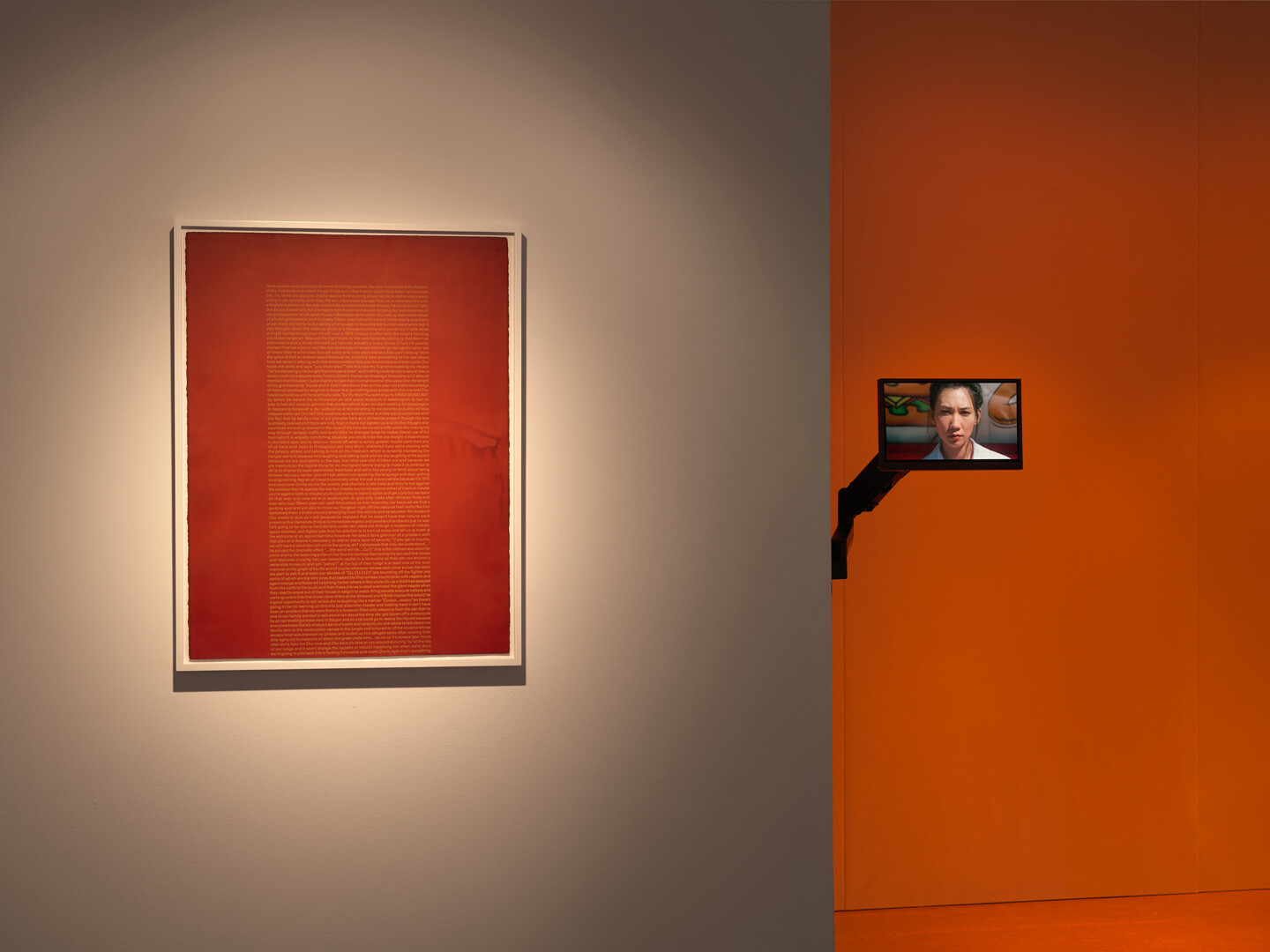

Exhibition view: “List Projects 26: Alison Nguyen,” MIT List Visual Arts Center, 2023. Photo: Dario Lasagni.
The experience of riding in the used limousine was so strange and darkly funny and tragic that at many points in my life I’ve thought I hallucinated it. My brother’s poem in some ways confirmed the past reality of this memory, or what I lovingly call the conspiracy of family. I think that as a child of a refugee, you’re dealing with a lot of emotions and experiences that you don’t yet have the language for. One of the roles of the artist or the writer is to kind of give form to those feelings and experiences that are so confusing, or radiant, or chaotic that they at first evade articulation. Memory, both personal and historical, is slippery. I think it has actually taken me a long time to wrap my head around why things are the way they are, both in myself and also within the larger context of culture. There is a point at which you realize that we are not simply shaped by our own will but also by the sweeping forces of history.
MJ: In history as hypnosis you’re attempting to unravel what’s omitted from history by uncovering this untold history or lived experience of individuals, even your personal family history. This reminds me of Svetlana Boym’s concept of the “Off-Modern,” which suggests that we need to rethink the porous nature of historical time and its relationship to contemporaneity.1 Like Raqs Media Collective in their essay “Now and Elsewhere,” your work seems to explore the complex layers of history, memory, and multiple temporalities.2
AN: It is porous. I see my family history as being shaped in part by infrastructures that arose during the Cold War. For context, my father is Vietnamese and my mother is American. My mother grew up in Wilkes-Barre, Pennsylvania, which is a postindustrial coal-mining town. Following World War II, the city’s economy declined due to the collapse of the coal industry. People were out of work. In 1979, Susquehanna River flooded, spilling over its dike-lined banks; dead bodies rose from the grave.
My father grew up in Saigon. He was born in 1955, the year after the Geneva Accords, which divided Vietnam into North and South. His father had a low-level job in the foreign service. In 1965 he was on assignment in Washington DC and, fearful of the political unrest back home in Vietnam, he jumped at the opportunity to bring his wife and youngest children over to the US in 1966. My father, his siblings, and his mother were able to remain in the US as refugees of war. The rest of the family did not make it out of Vietnam until the late seventies, after the country fell.
My parents met on the dance floor of a bar in Washington DC. Zooming out, I consider the broader implications of the war, such as the military-industrial complex and technologies like surveillance and cybernetics that were developed closely alongside US involvement in Vietnam.
History can weigh too much. Zooming back in, I’m left with my own experiences of it, which can be radiant, and horrible, and also darkly funny. As an artist I can only attempt to transform this.
MJ: Could you talk about your use of cinematic science fiction tropes, in both this current project and your past projects? It’s interesting how you’re trying to blur the line between the virtual and the real, especially considering that your previous projects primarily emphasized the virtual. How did you end up trying to challenge or explore the permeable nature between the virtual and the real as it relates to science fiction?
AN: In my previous work surrounding Andra8, I drew attention to the very thin boundary between the virtual and the real by creating a world which, while computer-generated, had a close resemblance to physical reality. More specifically, I created a kind of sunny neoliberal purgatory. [laughs] The primary “set” was the character’s work-from-home apartment floating in a virtual void. I jokingly called the work a “chamber drama.” It takes place primarily in one domestic virtual space that, at least in the beginning, could be confused with a physical space. I littered 3D found (or user-generated) objects all over the apartment in ways that approximated human clutter. The character’s speech sounds close to that of a human yet slightly off. It needed this detailing, this attention to pictorial and syntactical realism in order for the later breaks and ruptures in the world to be meaningful.
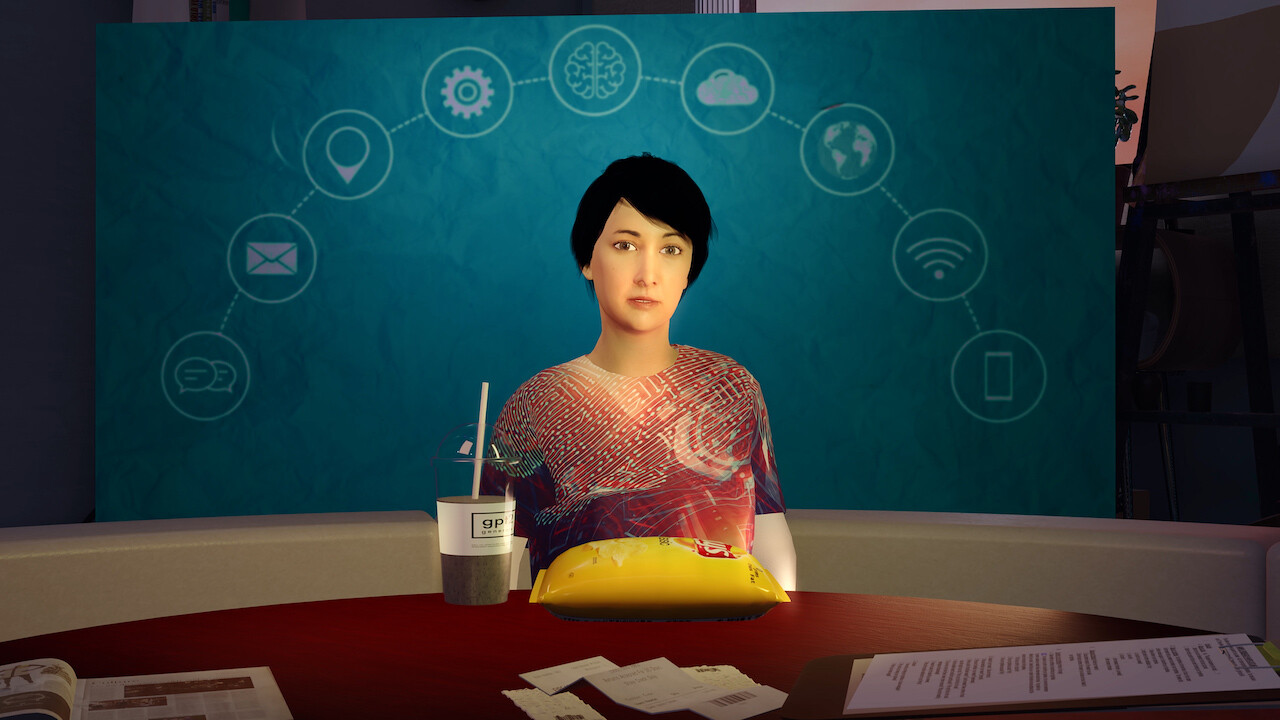

Alison Nguyen, my favorite software is being here, 2020–21. HD video, color, sound, 19 mins 47 secs.
In my opinion, one of the bland repeated themes in science fiction is an aspiration towards humanism. Why should human qualities or a human-inhabited world be what one strives for? There is a murky colonial underpinning to this metaphor. In both the Andra8 work and in my latest work I question this, though in different ways.
In history as hypnosis, AI forms the symbolic infrastructure of the world. Everything was shot in live action; there is no virtual computer-generated footage. And yet there is a feeling within the image that this is not quite dependable. What you’re looking at isn’t virtual; it also isn’t quite real. AI also serves as a character metaphor. The three protagonists appear as humans, though they have artificial consciousness. I thought this was a compelling fictional device to use in a work where the texture of the piece is documentary at times. There are no embellished or generated sci-fi elements; a readily shot American landscape is the truly strange milieu.
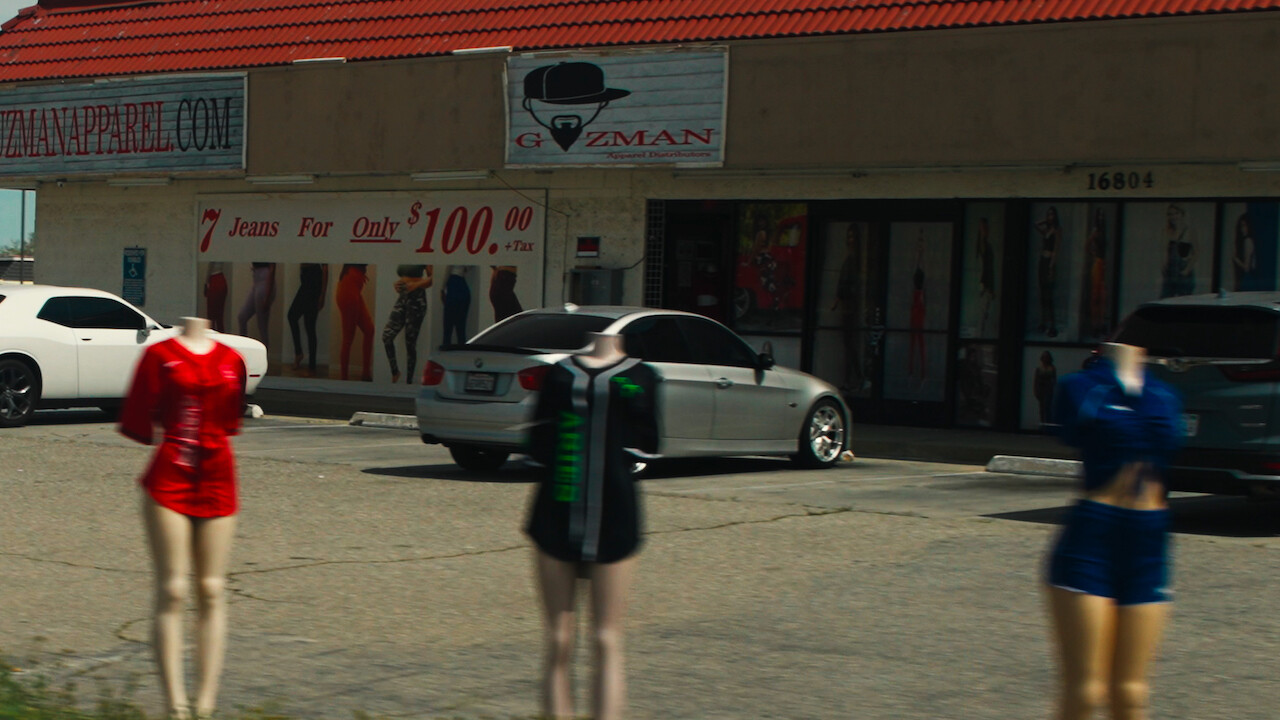

Alison Nguyen, history as hypnosis (Cinema Version), 2023. Single-channel video, color, sound, 30 mins.
MJ: In this film I could see that you’re wary of forgetting, as suggested by the characters who have their memories erased during hypnosis, which ironically heightens their awareness. This scenario also represents a resistance to fixed identities or history, creating an openness. Moreover, your effort to disrupt geneology, or perhaps to reinterpret the past, seems to be realized by disturbing linear narrative, or estranging aspects of mundane experience. I also like the way you zoom in on the history of consequences—for instance, of the US’s involvement in Vietnam, which works in a nuanced way without being foregrounded.
AN: Thank you. Earlier in my career I had difficulty finding a means to articulate my thoughts on these complex subjects. At least in the context of art or film it seemed as though, within much “diasporic” work, identity or a cataclysmic political event was always central to the concerns of the artist. There is a flattening that happens there, one that I consider to be dangerous. Is this reduction, which makes things easily palatable or understandable (to a predominantly white art world), the point of making work? Philosophically, I attempt to create a work that lives outside of the rules of history, that has its own terms of refusal.
MJ: Whose voices did you want to embrace in your work in relation to the periods of history you’re looking into? It seems like the process of memory is at the core of your work—the attachment and detachment from memory, its subjectivity or malleability. Time and temporal experience cannot be fixed into one notion, just like identity. How does your view of the memory process inform and shape your work?
AN: My process is an assemblage of personal elements and the external (interviews, text, etc.), which I consider to be artistic research. Many vignettes in the film draw from my own travelogues, images that came about in my own hypnosis sessions, or that are based loosely on details of oral histories I recorded with Vietnamese women my age (in their mid-twenties to mid-thirties) who immigrated to California during the 1990s and early 2000s. The project came about when I was studying with historian Lien-Hang T. Nguyen, whose work has a spatial focus on Southeast Asia and a temporal interest in the Cold War. The Vietnamese women I interviewed came through the US’s Orderly Departure Program (1980–97), a government-sanctioned program that enabled Vietnamese people to leave Vietnam and resettle abroad. Restarting their lives in this simultaneously resource-rich and innately alienating country, they spoke of the challenges in their early years.
In shaping the work, I wanted to create something that was deeply present but also had stark reverberations of the past. There is an early scene where the three women are in the desert and they fall to the ground when they see a helicopter passing overhead; in another scene, a barber glances out at them from a salon window and points a hairdryer at them. The car wash scene in the beginning involves archival recordings interspersed with the diegetic sounds. You don’t need to know it to know that’s what it is, but there’s an aggressive patterning. I worked with two sound designers, Jon Flores and Leslie Shatz, who advised. Their sound design articulates all the things that felt too contrived for me to express in visual language, or in performance, or in voice-overs. It’s amazing when collaborators can just see into the heart of of a work and very gracefully bring the brilliance and subtlety of their own practices into it. They work with their own extensive archives of original recordings, as opposed to generic Foley libraries. This makes such a huge difference. In the gallery where I installed the work at MIT’s List Visual Arts Center, we placed white acoustic sound paneling on the walls, just to preserve the details of the sound.


Exhibition view: “List Projects 26: Alison Nguyen,” MIT List Visual Arts Center, 2023. Photo: Dario Lasagni.
MJ: Speaking of design, architecture is very critical to understanding your work. I speak of architecture broadly, meaning buildings, computers, software design … or city architecture. These things impose power and authority, and they alter our perception in an invisible way. It makes sense that you’re interested in the ideas in Think Tank Aesthetics by Pamela M. Lee. Can you talk about your interdisciplinary approach and what architecture means in your work?
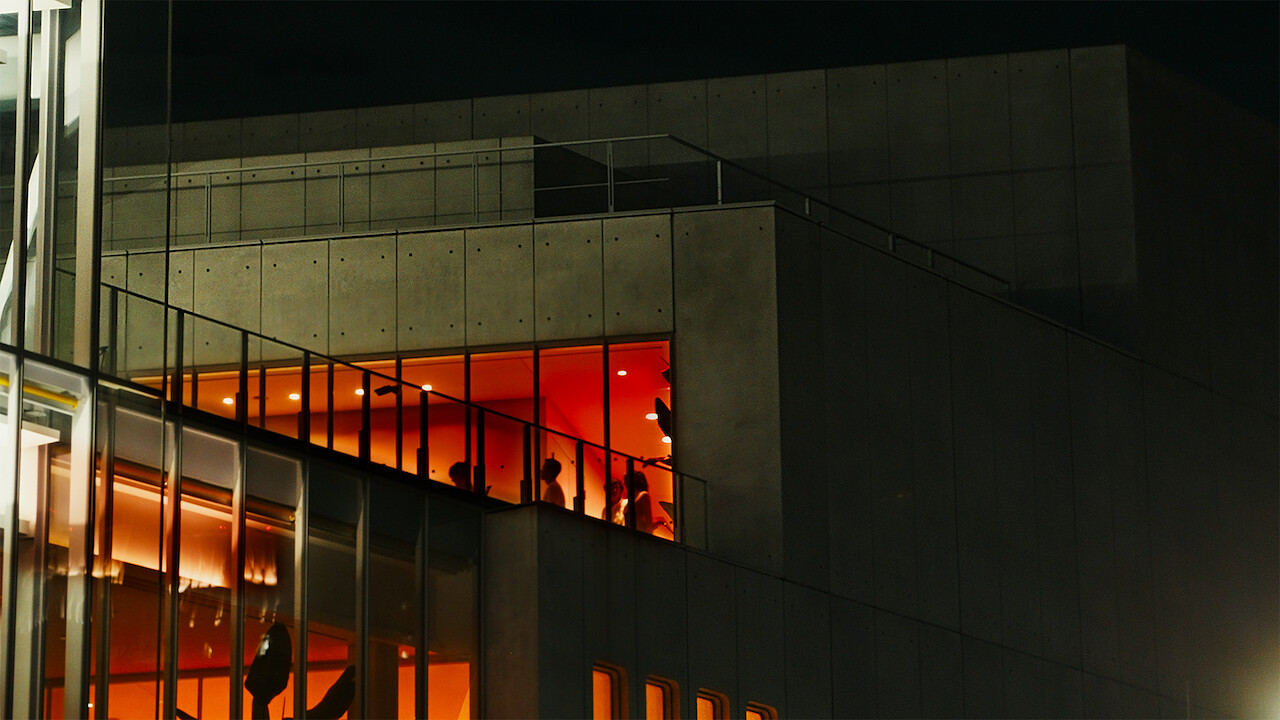

Alison Nguyen, history as hypnosis (Cinema Version), 2023. Single-channel video, color, sound, 30 mins.
AN: Architecture is so compelling to work with because it simultaneously embodies form, politics, economics, and ideas. I worked with scholar and architectural historian Reinhold Martin during my studies at Columbia. He would say, “If you look at a building you can see a world.” His work was influential in the development of history as hypnosis; through it I was able to parse the aesthetic and technological extensions of the military-industrial complex as they relate to architecture. Built structures within the film have a certain phantasmagoria of media embedded within them. The building where you see the AIs wearing white shirts, watching a training video—that’s shot in a Renzo Piano–designed building in Harlem, The Forum. It was right across the street from my studio. Looking at it every day from different angles, I realized it was a ready-made science fiction veneer. The Forum is publicized as a community building, though rarely do you see many people from the surrounding neighborhood using the ground-floor atrium. The upstairs meeting rooms and conference spaces are very expensive to rent and they are frequently empty. There’s an institutional eeriness to it.
Renzo Piano often incorporates what he calls “the city layer” into his designs—a glass expanse that goes alongside the street. So there’s a lack of distinction between the inside and the outside, and supposedly we’re all integrated. But it also serves as a point of surveillance from the inside. And from the exterior, it’s actually hard to see into the building at certain points because of the way it’s designed. So I think my dry assessment of it would be like, oh, the glass is the glass of a computer screen.
MJ: I was actually going to ask if that’s related to the materiality of the film.
AN: Glass and transparency is a kind of transitional modernist paradigm. It implies an equal footing between those on the interior and those on the exterior. In fact, this is markedly not equal footing. At the same time, everybody is such a sucker for the overuse of glass. It’s like the Instagram face of architecture.
Getting permission to shoot in Renzo Piano’s Forum was like an institutional critique performance. I had to go through so many layers of bureaucracy just to be told “no.” But I was really persistent. I told people who worked there about the project and was very candid about the Forum’s function within the story: I was using the architecture as the setting of a science fiction. It’s essentially a Google office where AI’s are trained. And that’s what got them in on the joke. Once they were in on the social critique I was making, the easier and more enjoyable things became. In filming, our footprint was really light. We walked in there, we rearranged some chairs, set up some children’s toys, put a video on the monitor, and then we shot. We were in and out.
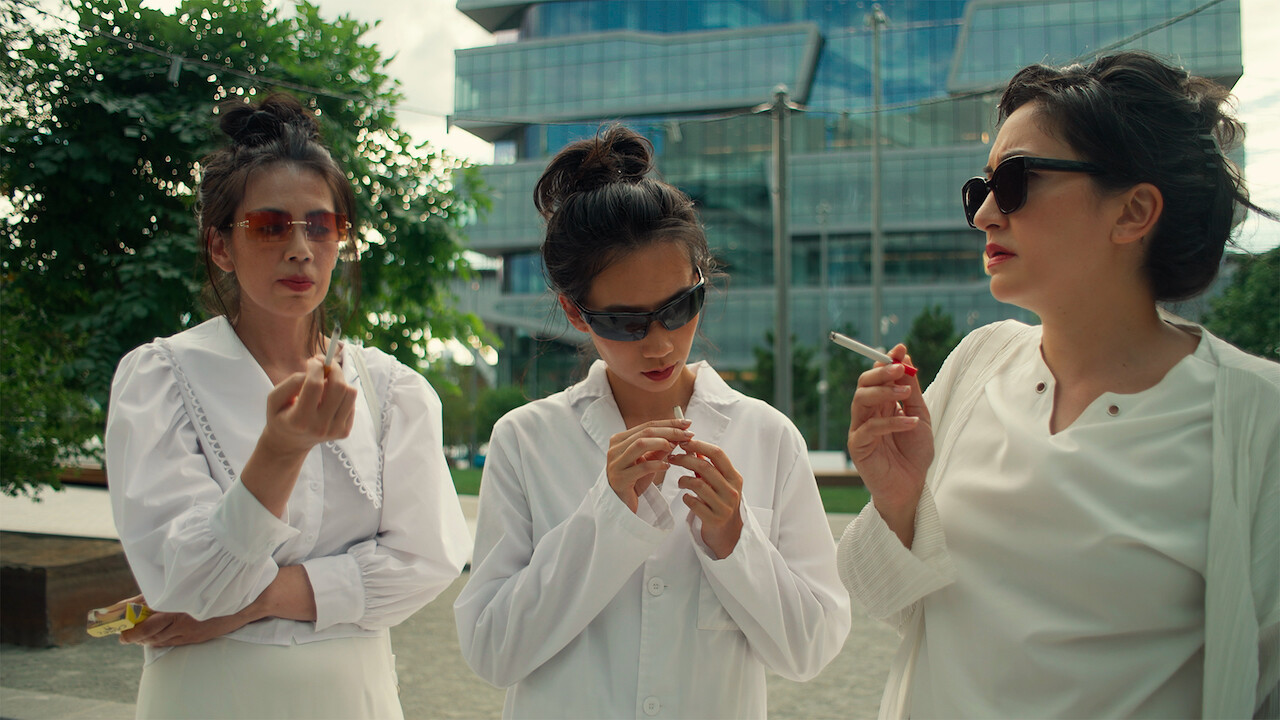

Alison Nguyen, history as hypnosis (Cinema Version), 2023. Single-channel video, color, sound, 30 mins.
MJ: Can you elaborate on your attempt to blur reality and imagination in the film? What were your observations on tropes in road films and road literature? Given your background as a writer—not just a visual artist but a writer and filmmaker—how did you want to explore these tropes? What do you intend to signify with the journey in your film?
AN: I’m drawn to forms with which I have complicated relationships. The road film I love actually as a genre, but at the same time, it’s also so problematic. I love films like Easy Rider, Thelma and Louise, My Own Private Idaho, and Paris, Texas. But in thinking of the genre as a whole, there are undertones of rugged individualism and US expansionism. In road films, the automobile is typically a signifier of independence; in reality, it’s not always that way. In my film you don’t know who’s driving a car. There’s a dead body that appears on the floor of the car and we never see it again.
Tropes are powerful tools to use because they allow the viewer to inhabit a ready-made form. But then being able to slowly show that this image is not dependable, or not what you think it is—that’s something I love. The trope is indicative of our culture, but it’s also not real, it’s not cinematic, and it’s not unreal. So you’re in a more suspended state.
Svetlana Boym, The Off-Modern (Bloomsbury, 2017).
Raqs Media Collective, “Now and Elsewhere,” e-flux journal, no. 12 (January 2010) →.